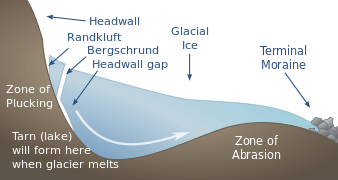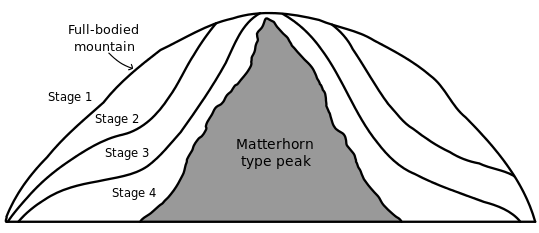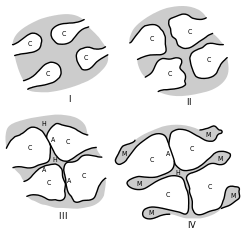Pyramidal peak


A pyramidal peak, sometimes in its most extreme form called a glacial horn, is an angular, sharply pointed mountain peak which results from the cirque erosion due to multiple glaciers diverging from a central point.
Formation
Glaciers, typically forming in drainages on the sides of a mountain, develop bowl-shaped basins called cirques (sometimes called corries or cwms). Cirque glaciers have rotational sliding that abrades the floor of the basin more than walls and that causes the bowl shape to form. As cirques are formed by glaciation in an alpine environment, the headwall and ridges between parallel glaciers called arêtes become more steep and defined. This occurs due to freeze/thaw and mass wasting beneath the ice surface. It is widely held that a common cause for headwall steepening and extension headward is the crevasses known as bergschrund that occur between the moving ice and the headwall. Plucking and shattering can be seen here by those exploring the crevasses. A cirque is exposed when the glacier that created it recedes.

When three or more of these cirques converge on a central point, they create a pyramid-shaped peak with steep walls. These horns are a common shape for mountain tops in highly glaciated areas. The number of faces of a horn depends on the number of cirques involved in the formation of the peak: three to four is most common. Horns with more than four faces include the Weissmies and the Mönch.[1] A peak with four symmetrical faces is called a Matterhorn (after the Matterhorn)[2]
| Stage | Description | Key | Description |
|---|---|---|---|
| I | Grooved upland | A | Arête |
| II | Early fretted upland | C | Cirque |
| III | Mature fretted upland | H | Horn |
| IV | Monumented upland | M | Monument |
The peak of a glacial horn will often outlast the arêtes on its flanks.[1] As the rock around it erodes, the horn gains in prominence. Eventually, a glacial horn will have near vertical faces on all sides. In the Alps, "horn" is also the name of very exposed peaks with slope inclinations of 45-60° (e.g. Kitzbüheler Horn).
Examples

Examples of horns include:
- The Matterhorn in Zermatt, on the border between Switzerland and Italy,
- The Kitzsteinhorn near Kaprun in Salzburg, Austria,
- Mt Blanc above Chamonix in eastern France,
- Mount Thielsen in Oregon, United States,
- Mount Wilbur in Glacier National Park, Montana, USA,
- Kinnerly Peak, Glacier National Park, Montana, USA,
- Pyramiden and Ketil in Greenland
- Reynolds Mountain, Glacier National Park, USA, and
- The Grand Teton, Wyoming, USA.
- Stob Dearg, (1022 m), Glencoe, Scotland
- Mount Assiniboine, (3618 m), British Columbia, Canada
- Mount Aspiring/Tititea, Otago, New Zealand
- Artesonraju, Ancash, Peru
- Nevado Las Agujas, Los Ríos Region, Chile
- Shivling (Garhwal Himalaya), Uttarakhand, India
- Store Skagastølstind, Sogn og Fjordane, Norway
- Puy Mary, Massif central, France
See also
References
- 1 2 Embleton, Clifford; King, Cuchlaine A. (1968). Glacial and Periglacial Geomorphology. New York: St. Martin's Press. p. 193. LCCN 68-20348.
- ↑ "Glossary of Glacier Terminology". US Geological Survey. Retrieved October 12, 2012.
Bibliography
- Easterbrook, Don J. (1999). Surface Processes and Landforms (2nd ed.). Upper Saddle River, NJ: Prentice Hall. pp. 334–336. ISBN 978-0138609580.
External links
- Lemke, Karen A. (2010). "Illustrated Glossary of Alpine Glacial Landforms". Retrieved October 12, 2012.

